Follow this simple recipe and video tutorial for the best all butter pie crust. It will make you a pie expert immediately! Complete with all my tips and troubleshooting, this pie crust recipe is buttery, flaky, and tender with the most incredible flavor.
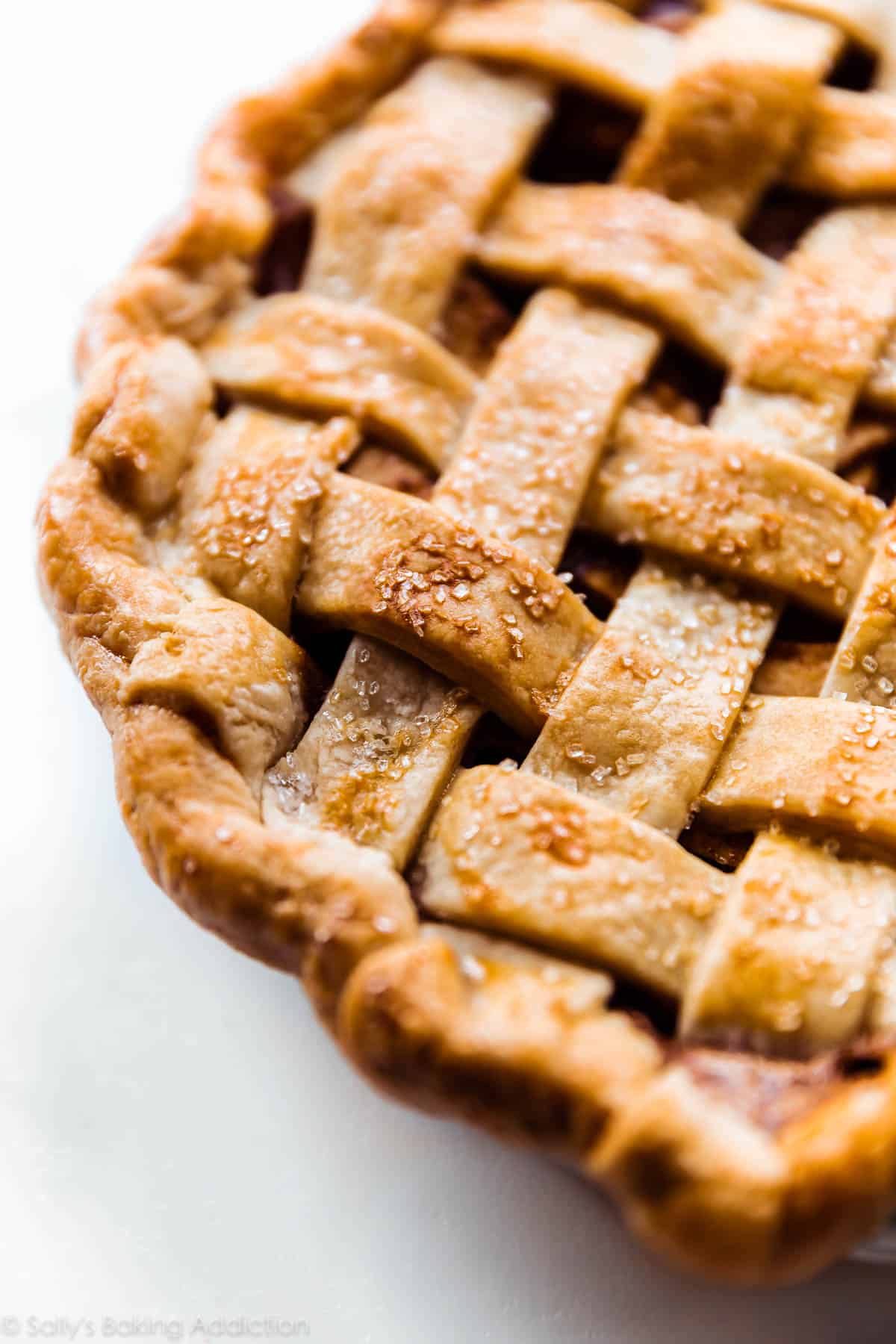
At the request of many, today I’m sharing my go-to all butter pie crust recipe. It competes with my butter and shortening pie crust for the #1 spot in my pie-loving heart. (Scroll to the recipe notes for my pie crust comparison!) I’ve made thousands of pies in my day and consider myself a pie expert. A pi-expert, if you will. I’ve made all the pie crust mistakes so I can coach you through the process and supply you with all the knowledge and confidence to tackle pie crust once and for all.
You’ll be a pi-expert with this recipe and tutorial on your side!
Watch my video tutorial for butter pie crust with lattice topping. This is my homemade apple pie with chai spices, a favorite every Fall season.
Start with a dependable pie crust recipe and you’re set for success. Soon everyone will be asking YOU for all your pie crust secrets.
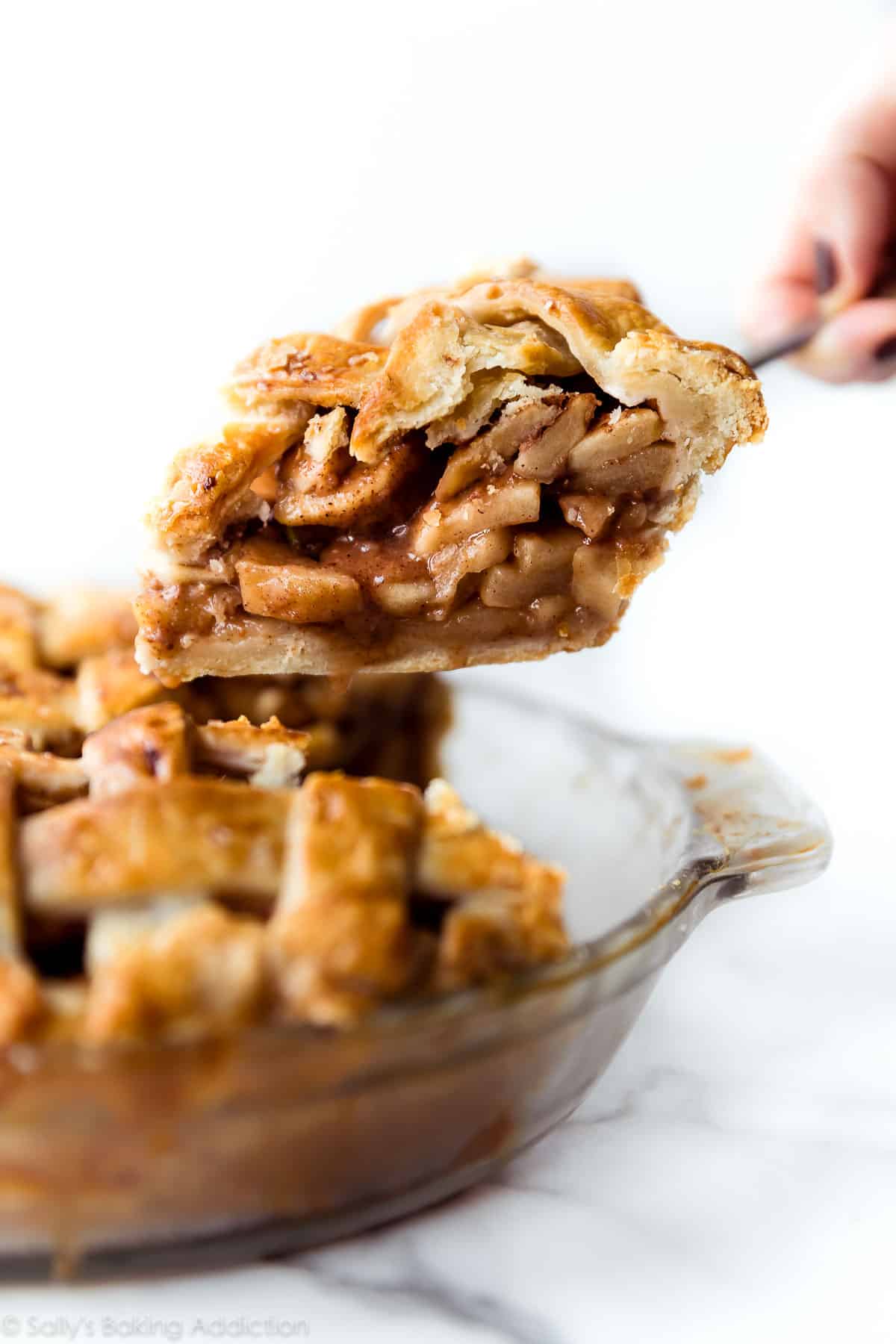
Only 5 Ingredients in Butter Pie Crust
This pie crust is made with 5 ingredients. Each ingredient has a very specific job. And with so few ingredients, it’s important to use the best quality.
- Flour – The structure of pie crust.
- Salt – Flavor flavor flavor. Use table salt instead of coarse salt. Smaller salt crystals dissolve and disperse more evenly throughout the dough.
- Granulated Sugar – Pie crust should not be sweet, but adding a little sugar to butter pie crust improves its flavor and enhances browning. The sugar crystals also help break down the hard pieces of butter.
- Cold unsalted butter – Supplies the pie crust’s unbeatable flavor and flaky texture. Use unsalted butter. The amount of salt in different brands’ salted butter varies, so for better control over the flavor, it’s best to begin with unsalted and add your salt.
- Ice water – The final ingredient, about 1/2 cup of ice cold water holds all the ingredients together. Use just enough so the dough holds its shape when rolling out. Many pie crust recipes don’t call for enough ice water, giving you a dry pie dough that cracks when you roll it out. When in doubt, add a little more water. You’re better off with more water (wet pie dough) than not enough water (dry, cracking pie dough) because you can always work more flour into the dough, but you can’t really add water to the pie dough when you’re trying to roll it out.
I use this crust in my apple cheddar pie—there I add some sharp cheddar cheese. It’s also the starting point for chocolate pie crust that we use for chocolate pop tarts!
Basic Pie Crust Steps
- Mix dry ingredients together.
- Cut in the butter with a pastry cutter or food processor.
- Add ice water a little bit at a time until the dough begins to come together. It will feel thick and moist, not overly wet. You’ll use around 1/2 cup (120ml).
- Mold pie dough into a ball.
- Cut in half. This recipe yields two 9-inch pie crusts.
- Flatten into discs. Wrap in plastic wrap.
- Chill for 2 hours before using.
These steps are shown in the video tutorial above and described in the recipe below.
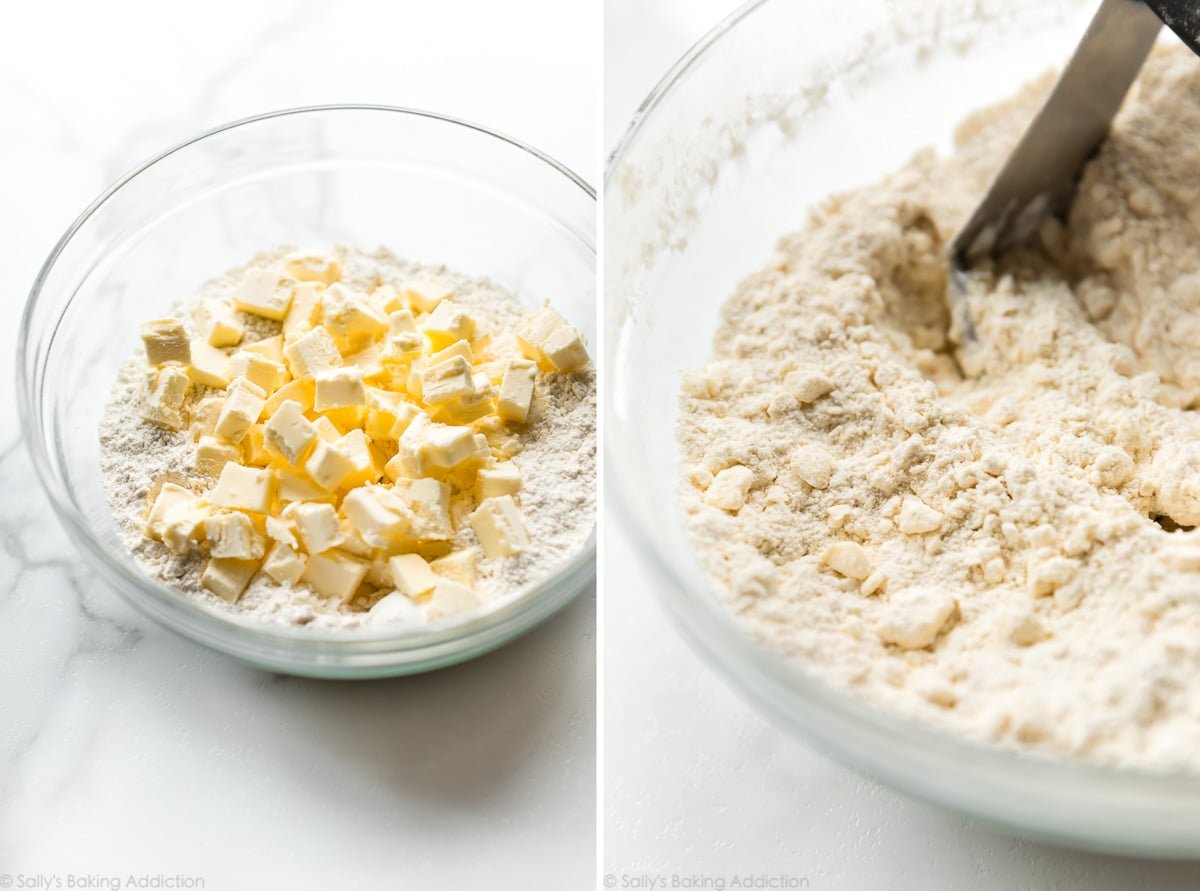
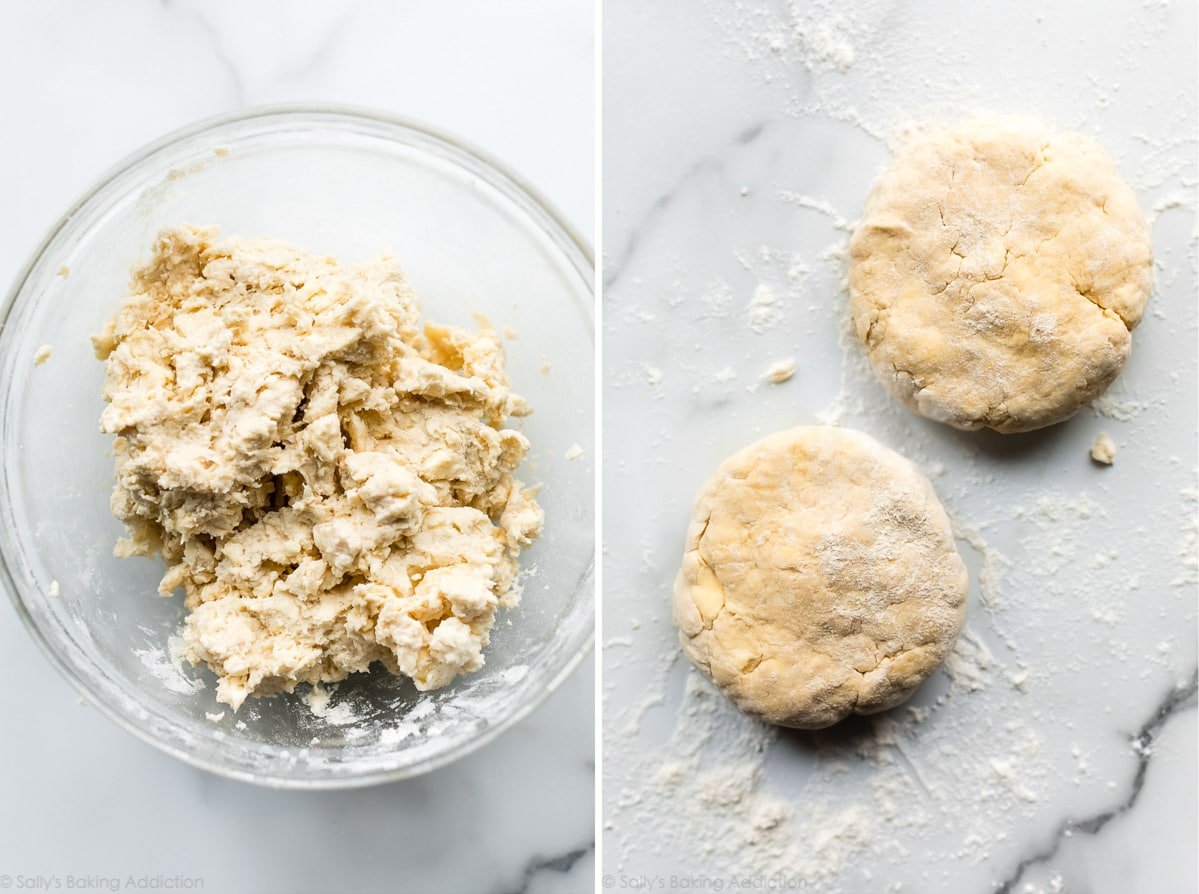
Why the Emphasis on Cold?
Keeping your pie dough as cold as possible prevents the fat from melting too soon. Too soon = before the pie crust enters the oven.
- What happens when the pie dough is warm? The butter in the pie crust will melt before baking, which means you lose all the flakiness and structure. Warm pie dough melts into a pool of grease. You’ll have a hard, crunchy, and greasy crust instead of a beautifully tender flaky crust.
- What happens when the pie dough is cold? The butter in the pie crust will melt inside the oven. Butter has a high volume of water content and this water converts to steam as the pie dough bakes. The steam separates the crust into multiple flaky layers, making this the most delicious pie crust ever.
The colder the dough, the flakier the pie crust.
How to Keep Pie Dough Cold:
- Use ice cold water. Fill a glass with 1 cup of water, add ice. You only need 1/2 cup of water in this butter pie crust recipe, but have a little extra just in case.
- Use cold butter. I keep some of my butter in the freezer and transfer it to the refrigerator a couple hours before beginning the crust. The butter is part frozen and very cold.
- Chill the pie dough for at least 2 hours before rolling out. This step is non-negotiable; it’s the most crucial in the entire pie crust recipe.
- For extra insurance, chill your flour and your mixing bowl in the refrigerator or freezer. Sounds a little silly, but trust me… it really helps!
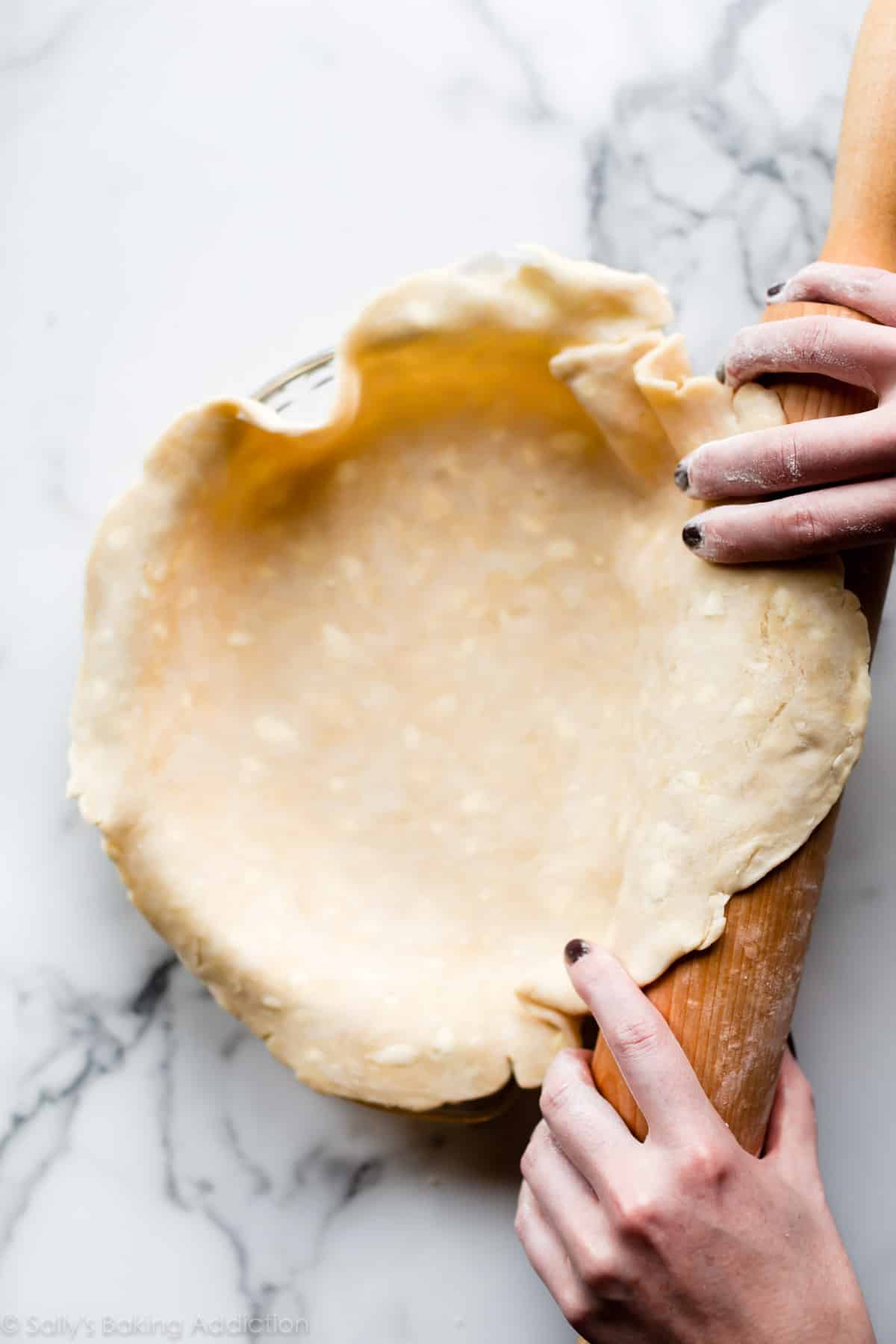
How to Roll Out Pie Dough
After the dough has chilled, it’s time to roll it out. Keep a small bowl of flour nearby to keep your work surface, rolling pin, and hands lightly floured. This prevents the pie dough from sticking. When rolling pie dough out, always start from the center and work your way out in all directions, turning the dough as you go. If the pie dough feels too warm or the butter is melting, stop. Lift it up, place on a baking sheet, and chill in the refrigerator for at least 10 minutes before continuing.
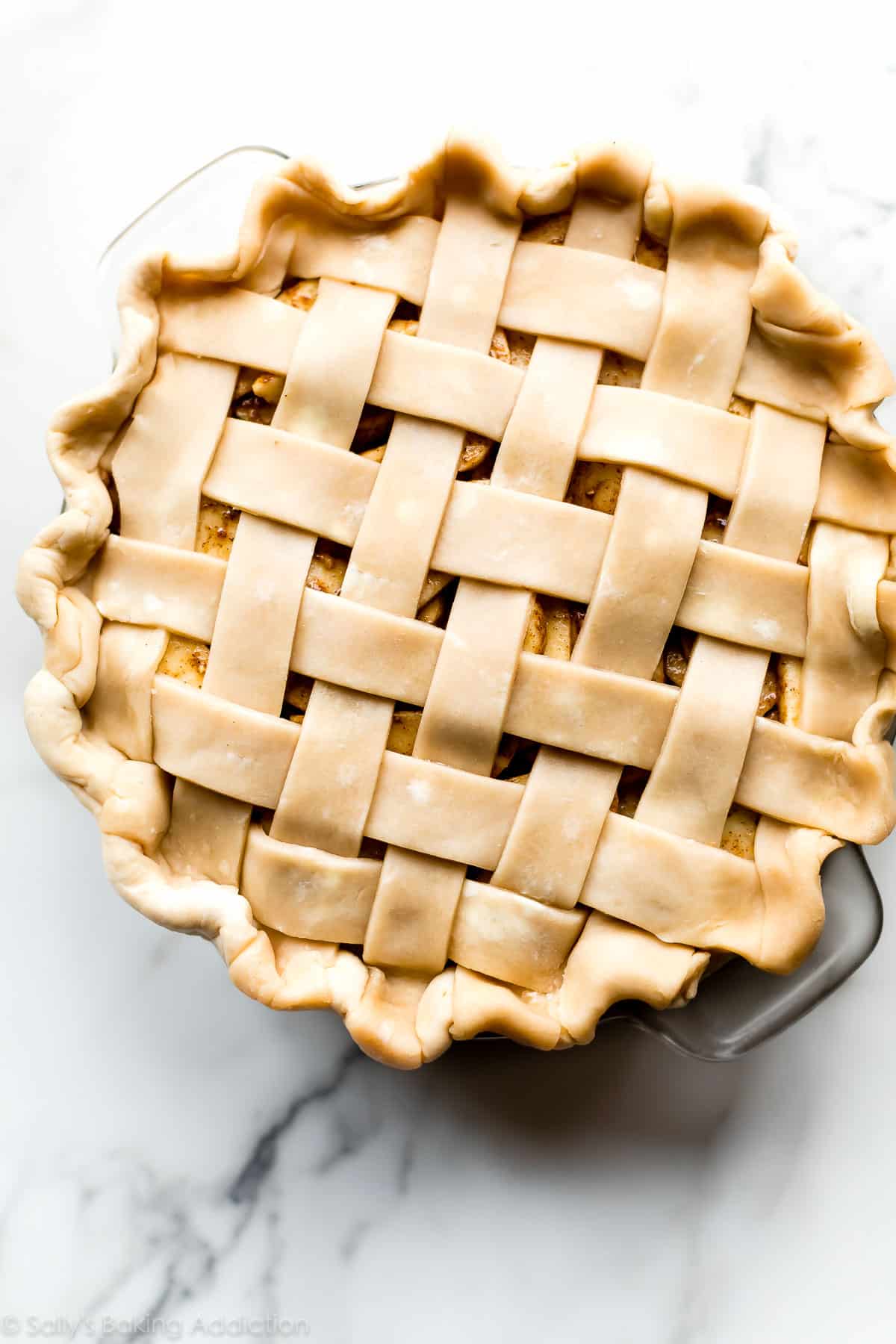
Butter Pie Crust Tips
- I’m going to repeat myself here. Keep all pie crust ingredients cold. On a hot day, you can chill the measured out flour in the refrigerator or freezer before starting. When taking the pie crust out of the refrigerator to roll out and fill, make sure your pie filling is ready to go. If not, keep the pie crust in the refrigerator until it is.
- Glass pie dishes are best. Why? As opposed to ceramic or metal pie dishes, glass pie dishes conduct heat evenly, which allows the bottom of the crust to bake thoroughly. Also, you can see when the sides and bottom of the crust have browned.
- If your pie recipe requires pre-baking (blind bake pie crust)—let’s say you’re making a pie with an especially wet filling—use pie weights or dried beans. Without pie weights, the pie dough will puff up, then shrink. Whichever you choose, be sure to line the crust with parchment or aluminum foil, then fill the empty pie crust with the weights. See my post and video tutorial for how to blind bake pie crust.
- Always use a pie crust shield. A shield keeps the crust edge covered, which protects it from browning too quickly or worse, burning. Use an adjustable silicone pie crust shield that you can fit to the size of your delicate pie crust. Metal can break the crust. Alternatively, you can cover the pie with a piece of aluminum foil. Cut a large circle in the center of the square so the center of the pie is exposed.
- Learn how to braid pie crust with my how to braid pie crust video tutorial.
- Learn how to lattice pie crust, too.
- Last but not least, learn how to crimp and flute pie crust. Those pretty decorative pie crust edges add function and flair!
Pie Crust Troubleshooting
- Prevent a crumbly pie dough that rips and tears when you roll it out. Make sure you use enough ice water when preparing your pie dough. Too little water creates an unworkable dough.
- Prevent a tough pie crust. Tough crusts are the result of not enough fat in the crust, as well as overworking the dough. Use the all butter pie crust recipe or my shortening and butter pie crust recipe to ensure a flaky, tender pie crust. Additionally, don’t work the dough too much.
- Prevent a burnt crust with a pie shield. See above.
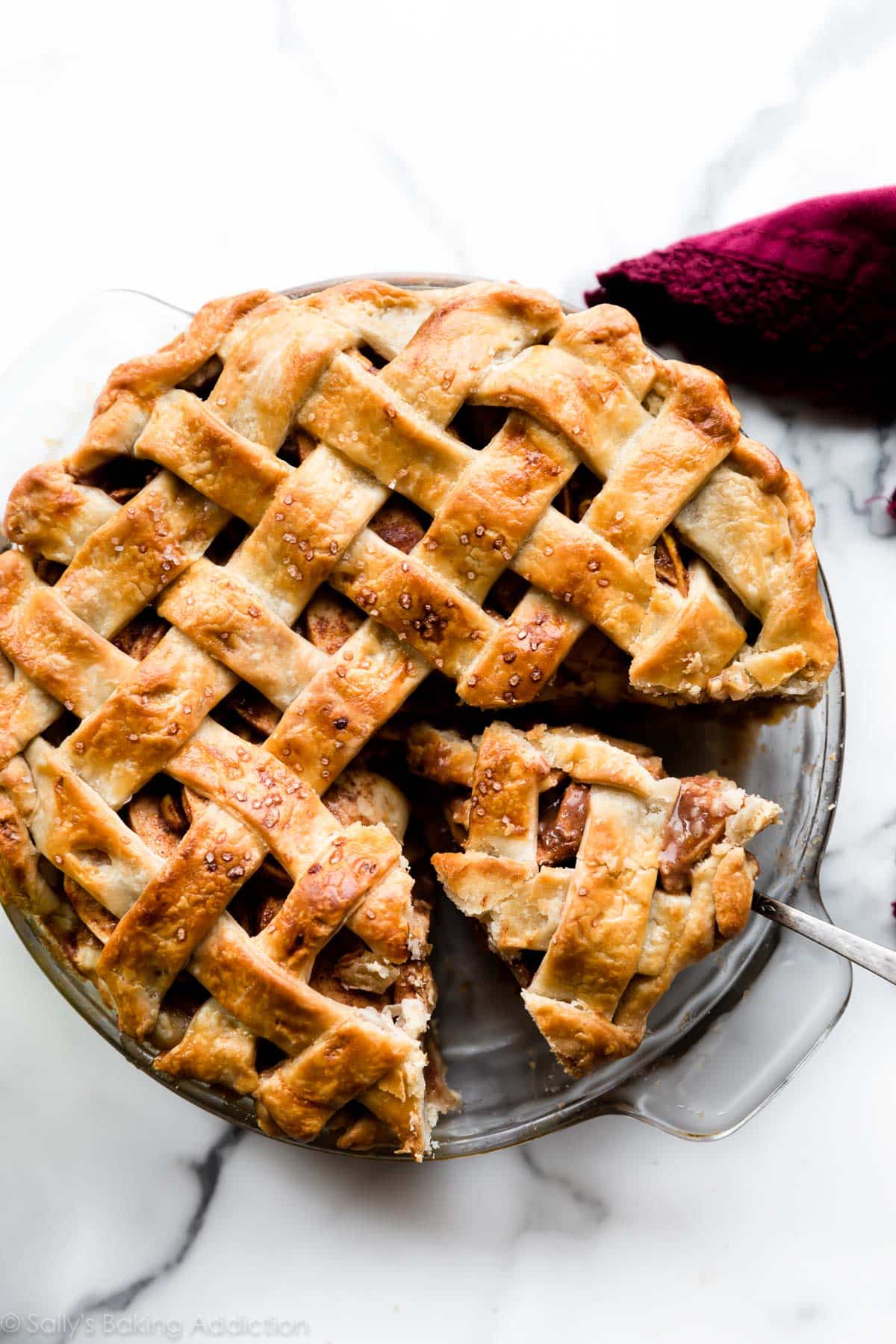
Recommended Pie Crust Tools
(All my recommend products are affiliate links. I trust these tried-and-true tools!)
- Pastry cutter – Though you can use a food processor to make this butter pie crust, I strongly recommend a pastry cutter to avoid over-mixing. Food processors are quick to over-work pie dough.
- Pastry mat – I prefer rolling pie dough out on a lightly floured counter because countertops are usually colder, but you can use a lightly floured pastry mat instead.
- Rolling pin – An obvious must with pie dough! I also love this marble rolling pin. Marble rolling pins are usually cooler to touch and we all know that pie dough loves the cold.
- Glass pie dish – My mother-in-law bought me this Pyrex pie dish 5 years ago and it’s been my go-to ever since. I have 4 of them now! Like I mention in my pie crust tips above, glass pie dishes conduct heat evenly, which allows the bottom of the crust to bake thoroughly. This is important. There’s no comparison, Pyrex is the best.
- Pizza cutter or pastry wheel – To cut your pie dough into strips for lattice decoration or any decoration. Have you seen my pie crust designs post?
- Pastry brush – An egg wash is simply an egg mixed with milk or water (usually milk). Lightly brush the pie dough with an egg wash using a pastry brush. The egg wash creates a golden, shiny, crisp crust. Without it, pie crust is dull and lacking color.
- Pie weights – These are crucial when you blind bake pie crust for no-bake or custard pies. Note: 2 packs of these pie weights is definitely needed!
- Pie crust shield – Pie crust edges are usually higher up than the center of the pie, leaving them exposed to the most heat. They brown quicker than the center of the pie, so it’s important to protect it with a shield. I usually place a pie crust shield on the pie about halfway through bake time. I recommend an adjustable silicone pie crust shield that you can adjust. Or you can cover the pie with a piece of aluminum foil: cut a circle in the center so the center of the pie is exposed.
Pie Recipes
Now that you’re fully prepared and equipped, here are several pie recipes to use your all butter pie crust. Pictured is my chai spice apple pie and I topped it with salted caramel in the video.
- Traditional Apple Pie & Salted Caramel Apple Pie
- Lemon Meringue Pie (a blind bake pie crust recipe)
- Caramel Pear Pie
- Pumpkin Pie
- Pecan Pie
- Banana Cream Pie (a blind bake pie crust recipe)
- Cherry Pie
- Peach Pie
- Blueberry Pie
- Sweet Potato Pie
- Fun recipes: Apple Hand Pies, Brown Sugar Cinnamon Pop Tarts, Pecan Pie Tarts
- Or any of my favorite Thanksgiving pie recipes!

All Butter Pie Crust
- Prep Time: 20 minutes
- Cook Time: 0 minutes
- Total Time: 2 hours, 20 minutes
- Yield: 2 pie crusts
- Category: Pie
- Method: Baking
- Cuisine: American
Description
Follow this simple recipe and video tutorial for the best all butter pie crust. It will make you a pie expert immediately! Complete with all my tips and troubleshooting, this pie crust recipe is buttery, flaky, and tender with the most incredible flavor.
Ingredients
- 2 and 1/2 cups (313g) all-purpose flour, plus more as needed (spooned & leveled)
- 2 teaspoons granulated sugar
- 1 teaspoon salt
- 1 cup (16 Tbsp; 226g) unsalted butter, chilled and cubed
- 1/2 cup (120ml) ice water, plus more as needed
Instructions
- Mix the flour, sugar, and salt together in a large bowl. Add the cubed butter on top.
- Using a pastry cutter, food processor, or two forks (pastry cutter is ideal, see post above), cut the butter into the dry ingredients until all flour is coated. You’re looking for pea-sized bits of flour coated butter. A few larger bits of butter is OK.
- Measure 1/2 cup (120ml) of water in a cup. Add ice. Stir it around. From that, measure 1/2 cup (120ml) of water since the ice has melted a bit. Drizzle the cold water in, 2 Tablespoons (30ml) at a time, and stir after each addition. Stop adding water when the dough comes together easily and begins to form large clumps. The dough will feel moist and a little sticky, but not feel overly wet. Do not add any more water than you need to. I always use about 1/2 cup (120ml) of ice water.
- Place pie dough on a lightly floured work surface. Using floured hands, fold the dough into itself until the flour is fully incorporated into the fats. Form it into a ball. Divide dough in half. Using your hands, flatten each half into a 1-inch thick disc.
- Wrap each disc tightly in plastic wrap and refrigerate for at least 2 hours and up to 5 days before using in a pie recipe.
- When rolling out the chilled pie dough discs, use gentle force with your rolling pin. Start from the center of the disc and work your way out in all directions, turning the dough with your hands between rolls. Smooth out the edges if you notice cracks. (See video above.) Keeping your work surface, rolling pin, and hands lightly floured makes rolling out easier.
- Proceed with the pie per your recipe’s instructions.
Notes
- Make Ahead Instructions: Prepare the pie dough through step 4 and freeze the discs for up to 3 months. Thaw overnight in the refrigerator before using in your pie recipe.
- Special Tools (affiliate links): Glass Mixing Bowl | Pastry Cutter | Silicone Spatula | Rolling Pin | 9-inch Glass Pie Dish | Pizza Cutter or Pastry Wheel | Pastry Brush | Pie Weights | Pie Crust Shield
- Pie Crust Comparison: Let’s see how this all butter pie crust recipe compares to my favorite buttery flaky pie crust, which uses a mix of shortening and butter. Due to butter’s high water content, this all butter pie crust is lighter textured with more defined flakes. As the crust bakes, the butter’s water converts to steam, creating thousands of deliciously light flakes. It’s also so buttery! However, because of all this butter, I find that the shortening and butter pie crust is a little easier to work with. Shortening has a higher melting point than butter, so the crust holds its shape wonderfully. Both crusts are fantastic, but if you are looking to make intricate pie crust designs I highly recommend my buttery flaky pie crust.
- Try This: Replacing 1 Tablespoon of ice water with cold apple cider vinegar creates an even flakier, more tender pie dough. It’s so tasty. Try it!



















Hey Sally have been making this and the shortening version of your pie dough for the better part of a year now and absolutely love them. I am having some difficulty with lattice tops and other designs as I find the pie dough stretches and thins out super easy (one side of a lattice or a braid will be thick and the other much thinner) I try freezing everything beforehand and even that doesn’t keep it from thinning out. Should I just lattice a small portion and freeze then do another small portion? Do the size of the chunks of butter effect this? How thick do you like to roll your dough for lattice top?
Do you have any tips or tricks!! Thanks for everything and sorry to bombard you with all these questions!
Hi Ben! Here’s our post on how to lattice pie crust that should have plenty of helpful tips for you.
Excellent all butter piecrust recipe. I used ice water with vodka and a food processor on pulse setting to incorporate the butter and basically just a few seconds of incorporating it all by hand into two discs for chilling. I notice that I can use more water/vodka when the humidity is low. Making strawberry/rhubarb today.
I love pie. I love baking pies. And I never use anything but this recipe anymore.
PS – I may already have left a review… I can’t quite remember, but this recipe is just so good.
I used this pie dough recipe and Sally’s lemon curd recipe to make lemon tartlets. I topped them with a raspberry and a mint leaf and it is so good. Highly recommend!
I’ve made this pie crust and the shortening/butter crust a few times and it seems like the all-butter crust always comes out tougher for me? I’ve tried the vodka trick and I keep putting the dough back in the freezer as needed to keep it cold while I’m working on it, but it ends up kind of hard compared to the shortening/butter crust. With either crust, I try to handle it as little as possible. I’ve been putting my butter in the freezer and then grating it. I also usually end up having to add a bit more ice water than the recipe calls for, maybe because I live in a fairly dry area?
Also, I do have kind of a weird oven since it’s a convection oven/microwave (and is the size of a large microwave) so I don’t know if that could have some connection to it, but I’d love to hear any thoughts you have on how I could make my crusts more tender.
Thank you for your help and all your excellent recipes!
Hi Catherine, It doesn’t sound like you are overworking your dough (usually the culprit of a tough pie crust). It may be your oven. Because shortening has a higher melting point than butter, it may be that it’s able to remain more tender in your oven. We bake all of our recipes in a conventional oven. If you must use a convection/fan oven for baking the general rule of thumb is to lower your temperature 25 degrees F.
Great recipe, use it all the time. But sometimes, and seemingly more often then not, butter from my crust leaks out and drips onto the bottom of the oven, burning, and causing lots of smoke. Any advice on how to prevent this? I’ve tried keeping the crust cold up to the moment it goes in the oven and making sure the oven is preheated appropriately
Hi MoMo, we’re so glad you love this recipe! When the pie dough is thicker, it has more structure. When it’s thinner– and if the pieces of butter are too large for the thickness– the butter will leak and/or the crust will taste greasy. We recommend working the butter into the dough more or starting out with smaller pieces of butter. Grating the butter with a box grater is a great idea in this case.
I notice in the shortening and butter pie crust you reference using cold vodka, but here you mention cider vinegar. Can you use vodka here, or is that not a good idea.
Hi Elaine, yes, you can use vodka here as well. Use 1/4 cup of ice water and 1/4 cup of cold, unflavored vodka. Hope this helps!
I have made this all butter crust many times and love it. Recommend to my friends, daughter, etc….. my question is: why would the crust be tough? I made it just as always and filled with your banana cream pie filling……it was delicious! Used the almond flavoring in the whipped cream and sprinkled cinnamon on the bananas. Yummy even though I did something wrong with the crust. Any ideas?
Thanks for your time and help.
Hi Linda, overworked pie dough will taste tough when baked. Make sure to just mix until combined and handle it as little as possible. Thank you so much for making and trusting our recipes!
Sorry (not sorry) to say goodbye to my Auntie’s pie crust recipe, which I have used for years, because this is my new go-to. Thank you!
I LOVE this pie crust so much I often make several to freeze and use later! I froze one and have kept it in the fridge for 5 days because I ran out of time to make my pie. Can I still use it today?
Hi Amy, Yes! As long as it was wrapped tightly you can refrigerate it for up to 5 days before using in a pie recipe.
Love this recipe! I’ve made it twice, once with the full recipie and then one with only half. Both turned out sole effect and would recommend to anyone!
Hi, I made my crust one day in advance of my coconut cream pie filling – do I leave the baked crust out overnight or refrigerate it? Thank you!
Hi Jen! We would cover tightly and leave at room temperature overnight.
I love this recipe!! It’s so easy and basically fool proof! So much better than those packaged crusts…I’ll never go back to those!
I’ve made this recipe several times now and it tastes great, but I have an issue with my pie dough shrinking when I do the blind bake. I follow all your steps, what can I do to prevent this from happening?
Follow the directions. Keep everything cold and this will work out perfectly. This was my most successful crust (and I’ve made a few) and the key is keeping everything cold, just like Sally says. I made this for Sally’s Chicken pot pie and it was fabulous. Thanks, Sally!
This is the very first time I made a homemade crust. It ended up ok but when I did the pre-baking the middle ended up a big puddle of butter. I soaked it up with a paper towel and put it back in the oven. I am just not sure what I did wrong.
Hi Julie! Thank you for trying this recipe and we’re happy to help troubleshoot. First, make sure you are using very cold ingredients! You can even freeze your flour for 30 minutes before beginning. The colder everything is the better your pie crust will turn out. Make sure your butter is super cold.
We recommend using 1/2 cup of ice water. For even more success, use 1/4 cup of ice water and 1/4 cup of cold, unflavored vodka. The vodka helps prevent the pie crust from shrinking and keeps it really flaky. All of the alcohol bakes out so you don’t have to worry about that. No matter what, use 1/2 cup of very cold liquid. Hope this helps for next time!
Wonderful pastry! I followed recipe exactly including chilling food processor bowl and blade. Needed more water but that was fine. I never thought you could achieve such a flakey pastry without spending hours layering and rolling like I have seen is done for puff pastry. Tip about using pie shield so edge doesn’t burn was great. I made out of foil.
For years, I have made pie dough with shortening. This year I thought I’d try using butter instead. I used your recipe and made it in the food processor. This is the flakiest, best pie crust I have ever made! It just melts in your mouth.
Hi, Sally. I’m making the pie crust and I have a question. Right now I’ve done all the steps right up to putting it in the fridge(mine is going in overnight and I’m going to work on it in the morning). It looks pretty good, and I think it should be fine. However, I noticed there were a lot of deep cracks around my pie crust when I made it into the round shape to put in my fridge. Is that normal or is there something I can do to fix it? I just don’t want to mess up. Thank you!
Hi Safaa, Cracked pie dough is easily fixable. If it’s cracking, moisten your fingertips and bring the cracked edges back together. Cracked pie dough is dry, so a little moisture will help. Use your fingers to “meld” any cracks back together– as if it were play doh.
This is the flaky pie crust of my dreams. It’s perfect. Truly perfect.
Hi,
A couple of questions. First, could I use this recipe for pumpkin pie? Also, what is the difference (taste and texture) from the original pie crust recipe? Second, could I freeze the butter and then grate the butter into the flour, just like you do with the scones? Thanks in advance!
Hi Owen! Yes, this recipe would work well for pumpkin pie. See the recipe notes for our pie crust comparison between this and our original. You can certainly use grated butter for making pie crust, just like we do for scones if you prefer. Happy baking!
Hi can I use this crust for quiches. Should I avoid the sugar? Would it be too sweet?
Hi Hazel, this crust is perfect for quiche!
This pie crust turned out great, with fabulous flavor and texture. My only issue is that I needed much more water. With only 1/2 cup, it was just too dry and crumbly to make a dough. I probably added another 1/4 cup before it started to hold together. I’m not sure what I might’ve done wrong
Hi Sandra, so glad it came together for you! How are you measuring your flour? Make sure to spoon and level to avoid packing too much flour into your measuring cups (by scooping). That would result in a dry dough. Hope this helps!
I agree. I had to use TWO more TBLSPN, but I am in a dry climate and I sense that may have something to do with it.
Hi Sally,
Is it okay to add a bit more sugar to this recipe to make the crust sweeter?
Hello! I’m actually making mini pies for my wedding, and plan on using this recipe. About how many cupcake sized pies this would make?
Hi Zoe, how exciting! You could certainly make mini pies using this recipe. We’re unsure of exact quantity and bake time as we haven’t tested cupcake sized pies. For a size reference, here are our apple hand pies (made with a *slightly* different crust) that makes 10-12 3.5 inch hand pies. Happy baking!
Sorry, the worst pie crust recipe I’ve ever made! Followed the recipe to a T and it was WAY TOO MUCH BUTTER!! The crust never dried, and was swimming in butter.
Me too. It seemed so promising. It rolled out so well but completely lost its shape and turned into a puddle during the blind bake. Never again. I’ve baked lots of crusts and know how to measure and to keep everything cold. Still the worst crust fail I’ve ever had.
Wonderful pie crust recipe! I have been using a different recipe for many years but decided to try something new. I’ll definitely be using this recipe for my future pies. I will say it was more difficult to roll out than the other recipe that I’ve used, but it was worth it!
Today is the second time I made this recipe and the sides fell down while baking. I followed the instructions to a T and it didn’t get a golden brown. The scraps I put butter and cinnamon sugar and baked- flaky and delicious. What am I doing wrong?
Hi Keo! Shrinking is usually a result of overworking the pie dough. Pie dough should only be mixed until the ingredients come together. Let it rest for at least 2 hours in the fridge– and if you can let it rest longer, awesome. Better yet, make the pie dough discs a few days in advance so they can rest during that time. Likewise, use gentle force when rolling out pie dough. Roll out very slowly and take your time. Keep the ingredients as cold as possible. You can even freeze the crust for 20 minutes before baking. That always always helps!
Hi Sally,
I have always enjoyed baking and am known for my cookies, which I distribute to my neighbors and dog walking/training clients regularly. My husband loves pie and pastry (naturally I make cake) and nothing I do ever seems elicit much enthusiasm except this gigantic chocolate cheesecake which I will make for him when he can take it to work, as I absolutely hate cheesecake.
Recently we made a trip to Cambria, where we went to a place known for pie. I do like apple pie so I got a piece and my husband got a berry pie…I am allergic. Well, on a whim, I asked if they used butter in their crust (it was very good) and I was told yes…and lard…
Well, my husband and I are Jewish so we both kind of turned green. So…then and there, I decided I would make an all butter pie crust, since I just never use shortening and don’t keep it around.
I found your recipe, watched the video, read it at least 7 times and got to work. I put the flour in the mixing bowl and refrigerated it. I put the butter in the freezer for an hour. I got a new pastry blender and got to work. Once the dough was made I refrigerated it for two days because I had no time to bake on Monday. Then Tuesday afternoon I made up an apple pie filling and when it cooled, I made up the crusts. I assembled the pie, following your directions very carefully, and baked it. Oh, my….it came out perfectly! Even my husband paid me a compliment, which almost never happens.
Thank you so much for your wonderful instructions. I will be making pie again and will look through your site to find other things I have previously been too cowardly to try!
Hi Lucy! We are SO happy to read this sweet review from you. Thank you so much for giving this recipe a try!
Just made it a second time. perfect again. Just follow the recipe exactly…
Hey Sally, I am about to make this all butter pie crust for your apple handpie recipe. I have a question though; in your recipe for the flaky pie crust (butter + shortening) you have added a note about adding 1/4 cup cold vodka + 1/4 cup cold water to make a dough flakier, can I use the same for this all butter pie crust?
Hi Nitya, you certainly can!
Thanks Lexi
Hi Sally, thank you for a wonderful recipe, we love this crust so much. We used this for your mini galette recipe and it was such a huge hit. I forgot to chill it before rolling it out but using it with some flour worked out well (perhaps because we are in a colder region and there is no humidity). Thanks again!